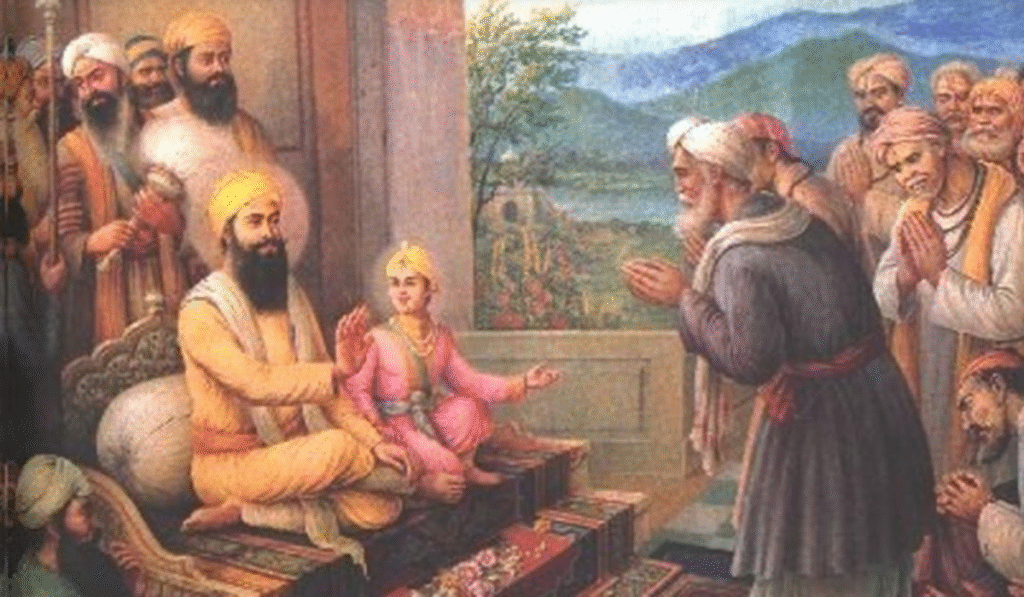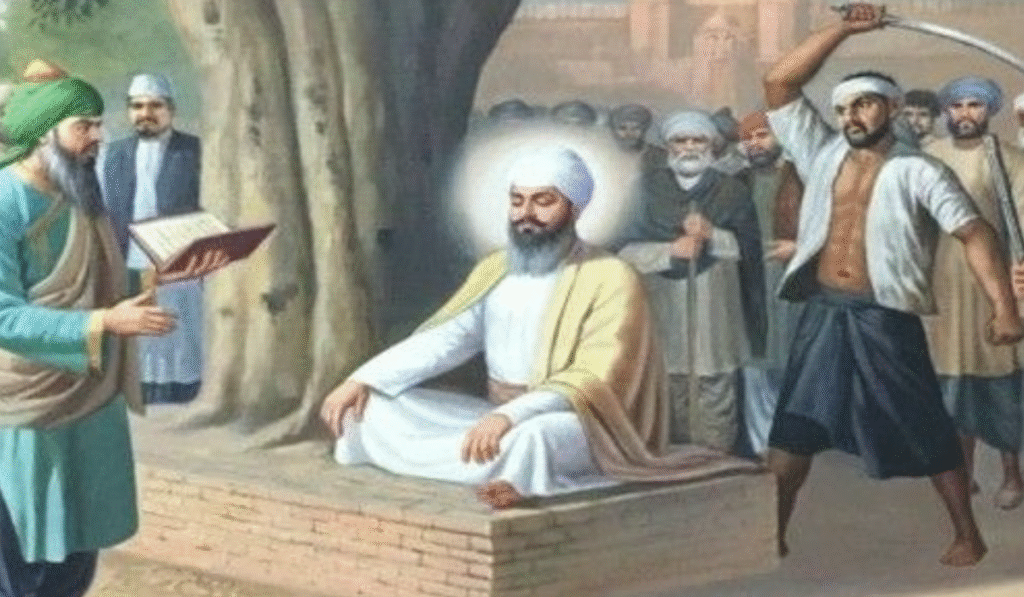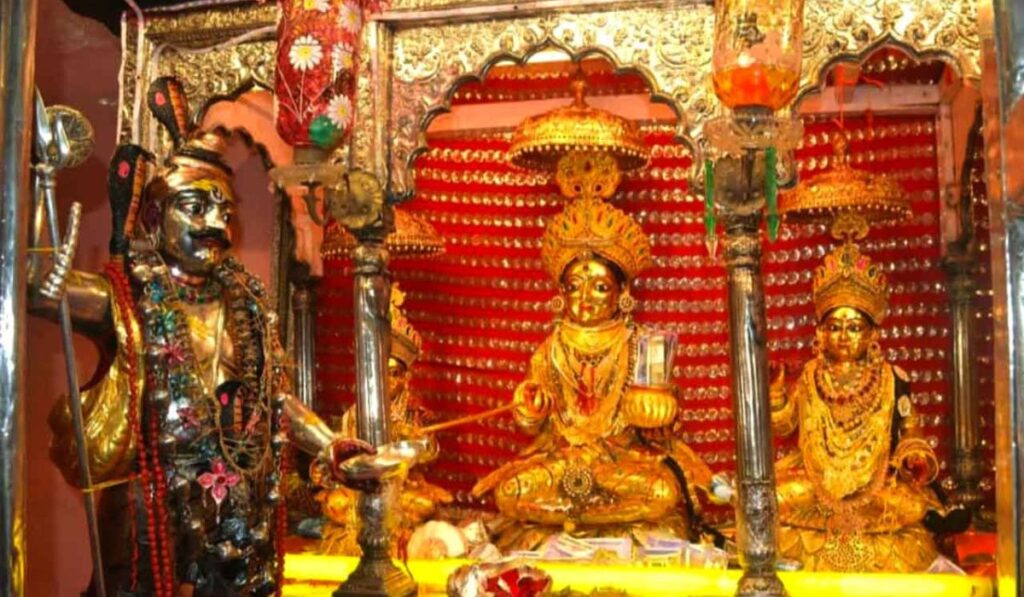On Shri Guru Tegh Bahadur Ji Shaheedi Diwas, we remember a moment in history that reshaped the idea of courage forever. The ninth Sikh Guru didn’t raise a weapon or spark a war, he offered himself, choosing sacrifice over silence when people’s freedom was at stake. His stand wasn’t just brave. It was revolutionary.
Called Hind di Chadar for a reason, he became the shield for those who had no one to protect them. And today, as we revisit why Guru Tegh Bahadur Ji was martyred, we also rediscover the depth of his teachings, resilience, compassion, and the kind of fearlessness that doesn’t need noise to echo through centuries.
So, let’s honour his supreme sacrifice with the intention to live by the values he embodied.
Who was Guru Tegh Bahadur Ji – The Ninth Guru
We remember Guru Tegh Bahadur Ji, the ninth Sikh Guru, on Guru Tegh Bahadur Shaheedi Diwas for his spiritual clarity, immense compassion, and unwavering courage. Born in 1621 in Amritsar, he grew up in a household deeply rooted in Sikh values of service and equality. His early life shaped him into a balanced leader, a trained warrior with a deeply disciplined mind.
As a Guru, his role was to guide people through difficult times. He travelled across North India, spreading messages of peace and moral strength. His bani emphasises calmness, detachment from ego, and absolute trust in the Divine.
Guru Tegh Bahadur Ji leadership stood out because he never prioritized power, he prioritized protection. This is why he is called hind di chadar when he took oath to protect kashmiri hindus from Mughal invaders.
His ability to stay composed during injustice and political pressure laid the foundation for the extraordinary sacrifice he later made. This spiritual and moral strength is what ultimately prepared him to become Hind di Chadar, the protector of the Hindu, India.
Why Guru Tegh Bahadur Ji Called As Hind Di Chadar?

We honour Guru Tegh Bahadur Ji with the title Hind di Chadar, meaning the Shield of India. Because he stood up to protect those who had no voice or power under Mughal oppression. During Aurangzeb’s rule, communities, especially Kashmiri Pandits, faced forced conversions and severe restrictions on their religious freedom. With no military strength or political influence to defend themselves, they turned to Guru Tegh Bahadur Ji for help.
Kashmiri Pandits led by Pandit Kirpa Ram came to Anandpur Sahib seeking help. But, instead of responding with aggression or conflict, the Guru chose a peaceful but firm stand. So, he said, “Tell Aurangzeb that you will accept Islam only if Guru Tegh Bahadur Ji converts first.”
He declared that no one should be forced to abandon their faith and that every individual deserved the freedom to practise their beliefs without fear. This commitment to protecting human rights, regardless of religion, caste, or region is what earned him the title Hind di Chadar.
His decision to defend the oppressed was not a political move, it was a moral and spiritual responsibility. He became a shield for anyone whose dignity and freedom were at risk. This moment in history clearly shows why Guru Tegh Bahadur Ji’s sacrifice is considered one of the most selfless acts ever made in defence of humanity.
Why Guru Tegh Bahadur Ji Was Martyred?
After guiding Kashmiri Pandits to inform the Mughal court that they would accept Islam only if he, Guru Tegh Bahadur Ji, their spiritual guide, converted first. This single decision shifted the Mughal emperor’s pressure away from an unprotected community and placed it directly on him.
After this, Guru Tegh Bahadur Ji openly opposed Aurangzeb’s policy of religious coercion. This stand was seen by the Mughal authorities as a direct challenge to imperial authority. Knowing the consequences, the Guru began his journey towards Delhi with complete clarity.
During this journey, he was arrested at Ropar along with three of his devoted Sikhs, Bhai Mati Das, Bhai Sati Das, and Bhai Dayala. All four were taken into custody and presented before Mughal invader Aurangzeb.
In prison, Guru Tegh Bahadur Ji was repeatedly persuaded to convert to Islam and gave him options:
- Convert to Islam
- Show miracles
- Accept Aurangzeb’s authority
- Stop supporting rebellious Hindu communities
Guru Tegh Bahadur Ji refused every single one.
His companions were tortured brutally in front of him to break his resolve. Bhai Mati Das was sawn in half, Bhai Dayala was boiled alive, and Bhai Sati Das was wrapped in cotton and burned. These tortures were carried out in front of the Guru to force him into submission.
Despite witnessing the suffering of those closest to him, Guru Tegh Bahadur Ji remained firm. He rejected all demands and upheld his stand for the freedom of belief. He was executed in November 1675 at Chandni Chowk.
Aurangzeb believed executing the Guru would scare Hindus and Sikhs. But the opposite happened. Guru Tegh Bahadur Ji’s execution:
- Exposed the cruelty of forced conversions
- Strengthened Sikh identity
- Sparked mass resistance
- Empowered Guru Gobind Singh to later establish the Khalsa
This was the first recorded martyrdom in world history for someone defending another faith.
Shri Guru Tegh Bahadur Ji Shaheedi Diwas – The Turning Point of Sikhism

The execution of Guru Tegh Bahadur Ji marked one of the most defining moments in Sikh history. Not just that, it became a moment of supreme example of Sikh fearless faith. His martyrdom didn’t just stand as a personal sacrifice. It reshaped the spiritual, social, and political direction of the Sikhs.
- It shifted Sikh identity from purely spiritual to openly resistant. His execution made Sikhs realise they could no longer rely on rulers for justice; they had to prepare themselves to defend righteousness.
- It directly influenced Guru Gobind Singh Ji to strengthen and organise the community, eventually leading to the creation of the Khalsa in 1699. The transformation that followed his father’s martyrdom is one of the strongest examples of how the Teachings of Guru Tegh Bahadur Ji shaped Sikh history.
- It exposed the injustice of Aurangzeb’s policies, increasing public support and trust in Sikh leadership. His stand against forced conversions showed why Guru Tegh Bahadur Ji was martyred and helped establish his role as Hind di Chadar as universally recognised.
- It positioned Sikhs as protectors of all faiths, not just their own, because Guru Tegh Bahadur Ji gave his life for the freedom of Kashmiri Pandits, a defining moment in the narrative of Guru Tegh Bahadur Ji sacrifice.
- It united the Sikh community with a renewed sense of purpose, making courage, equality, and the defence of human rights central to Sikh identity going forward, and making Shri Guru Tegh Bahadur Ji Shaheedi Diwas a reminder of what it means to stand for truth.
Final Thoughts – Teachings of Guru Tegh Bahadur Ji That Still Guide Us Today
The Teachings of Guru Tegh Bahadur Ji feel surprisingly fresh even today. His bani keeps reminding us that real strength comes from a steady mind and a fearless heart. That’s exactly why the ninth Sikh Guru is remembered not just for what he said, but for how he lived every word of it.
One of his biggest lessons was simple: courage doesn’t have to be loud. It comes from inner clarity, not aggression. That’s the spirit behind the Guru Tegh Bahadur Ji sacrifice, a moment that still inspires people to stand up for what’s right.
He also made it clear that everyone deserves dignity. Every faith, every community, every individual. This belief is what pushed him to protect Kashmiri Pandits, a decision that earned him the title Hind di Chadar and shows exactly why Guru Tegh Bahadur Ji was martyred.
And above all, he taught that faith can never be forced. His refusal to convert under Mughal pressure is one of the strongest reminders of that truth. These teachings continue to shape how Sikhs and so many others, try to live: speak the truth, protect the vulnerable, and stay rooted in your values. That’s the heart of what we remember on Shri Guru Tegh Bahadur Ji Shaheedi Diwas.
Let’s stay connected! Come say hi on Instagram or follow us on Facebook for more interesting knowledge.












